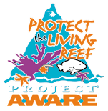Rags II: Apo Reef / Coron Wrecks: Trip Report
By Karl H. Epp (text) and Tony Exall (video)Day 1:
We (Karl of Philippine Dive Tours and Tony of TXL Underwater Videography) are currently in Puerto Galera. We plan to join a 7 day dive safari on board the Rags II to Apo Reef and Coron.
We are welcome by Ralph Joerger, he is the boat manager, dive instructor and an avid tec diver. He arranges the transfer from Sabang to the boat and gives us a safety briefing and an overview on what to expect on the upcoming days.We leave for Apo island Nature Park at around 5 pm. All in all we are 10 divers, me and Tony, Johan, Pete and Eric (Dutch), Martin and Sophie (Danish), Rob (USA), Tony (Austria) and Graham (England).
Tony and I are positively surprised by the size of the boat; RagsII is actually much bigger than we had expected, judging by the pictures on their website. The boat is spotless clean, spacious and very well organized; one can clearly see that she was designed for scuba divers, by scuba divers. On the dive deck are two benches either side of the boat, tanks with our name tags on are already in place when we boarded the ship. Below the benches are boxes for our dive gear. In the centre is a big table which gives us ample space for underwater cameras and video gear. On a second level below the table top we can store additional dive equipment. The benches and all surfaces of the table are covered with rubber mats to protect our equipment. Once we have set up our dive gear it stays in place, we will always use the same tank since they are filled by a flexible hose which runs under the roof. I check out the compressor area at the stern and I am delighted to see that they have 2 compressors on board, one as a back up. A continuos flow nitrox blending system is in place and there are lots of oxygen tanks for technical divers. Nitrox is for free anyway, if a diver doesn’t have a certificate a course can be conducted on board. Just a perfect set up.
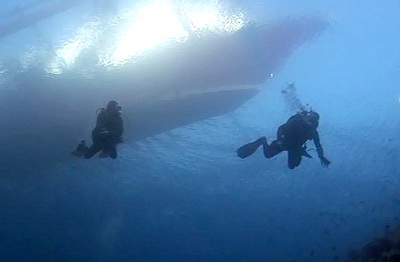 The cabins are snug, simple and spotlessly clean.The aircon is so positioned that it doesn’t blow directly on the bunks, which is very nice (unfortunately I already have a really bad cold!)A small light is positioned above each bunk, in case you want to read at night. The cabins smell fresh, which is not always the case on some liveaboards!
The cabins are snug, simple and spotlessly clean.The aircon is so positioned that it doesn’t blow directly on the bunks, which is very nice (unfortunately I already have a really bad cold!)A small light is positioned above each bunk, in case you want to read at night. The cabins smell fresh, which is not always the case on some liveaboards!
Lots of power outlets in the lounge are available for charging batteries and power packs. A TV and DVD player are present too.
Dinner is served on plates, there is no buffet. The menu is on display in the kitchen, we are told that if you have any special wishes the cook will accommodate you (as it turns out the Dutch are big eaters and request double portions, which they get).
The food is very tasty and plentiful. Additionally, fruit and cookies are always available for snacks in between. Beer is free on board which makes our Dutch friends especially happy! Also, wine is offered at 600 Pesos per bottle.
We are lucky with the weather and have a pretty smooth ride overnight to our first destination, Apo Reef.
Day 2
Dive sites of the day:
- Apo South East point
- Apo South West Point
- Light House Wall
- Apo West side
Apo Island - South East Point
 When we wake up in the morning, anchored close to Apo Island, we are greated by a gorgeous sunrise. The weather is brilliant, a clear blue sky and deep blue sea with no wind or waves, promises to be a great diving day. As we move over to a mooring buoy for the first dive a turtle sticks her head out of the water as if to welcome us to Apo Reef
When we wake up in the morning, anchored close to Apo Island, we are greated by a gorgeous sunrise. The weather is brilliant, a clear blue sky and deep blue sea with no wind or waves, promises to be a great diving day. As we move over to a mooring buoy for the first dive a turtle sticks her head out of the water as if to welcome us to Apo Reef
At 7am, after some coffee and bananas, we gear up for the first dive and enter the water.Apo is famous for its good visibility and we’re not disappointed. Viz is 40-50 meters and lots of the usual colourful coral fish roam the reef below us. We descend and after fixing a small problem with Tony’s camera, commence our dive. We see some mackerel, jacks and big eye trevally and dive along the vibrant reef. We have several encounters with white tip sharks in about 16 meters. A huge school of black snapper passes by. Unfortunately there is no current and not much in the way of big things or pelagic schools come in to say hello, all the same still a nice dive and everybody is very happy.
Apo Island - South East Point
10:30 am dive: I have to skip this dive because of my cold. The Dutch divers are the first one back and they are very excited. Several sharks circled the boat when they exited the water, white tips in just 5 meters of water. They are also impressed by the coral coverage at this site.
Tony reports lots snappers and drummers,harlequin sweetlips, big schools of pyramid butterfly fish, lots of fusiliers coming out of the blue to the cleaning stations, at greater depth some giant travelly and several napoleon wrasse. During lunch, we see several turtles from the boat.
Visit to Apo Island
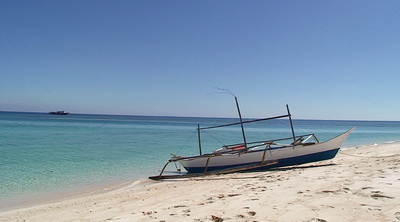 Tony and I decide to pay a visit to the ranger station on Apo Island. Two rangers are based here to protect the vast marine park. We have a chat with them and take some photos and head off to the lagoon. To get there we have to follow a tiny path cut through an otherwise impenetrable mangrove jungle. The path is more like a series of bamboo bridges anchored on mangrove branches. It’s a bit tricky to keep balance on these tiny bamboo beams, some of them are pretty rotten, and murky water lurks just below them.The only thing lacking to make the scenery fit an Indiana Jones movie are crocodiles and big snakes (though our guide assures us that the snakes are there, but alas, no crocodiles). After about 100m the pathway opens up to a stunning secluded lagoon, surrounded by a lush mangrove jungle.The scenery is absolutely striking; I have never seen anything like this. Unluckily for me my camera is for some reason not working and I can’t take any pictures.
Tony and I decide to pay a visit to the ranger station on Apo Island. Two rangers are based here to protect the vast marine park. We have a chat with them and take some photos and head off to the lagoon. To get there we have to follow a tiny path cut through an otherwise impenetrable mangrove jungle. The path is more like a series of bamboo bridges anchored on mangrove branches. It’s a bit tricky to keep balance on these tiny bamboo beams, some of them are pretty rotten, and murky water lurks just below them.The only thing lacking to make the scenery fit an Indiana Jones movie are crocodiles and big snakes (though our guide assures us that the snakes are there, but alas, no crocodiles). After about 100m the pathway opens up to a stunning secluded lagoon, surrounded by a lush mangrove jungle.The scenery is absolutely striking; I have never seen anything like this. Unluckily for me my camera is for some reason not working and I can’t take any pictures.
Off we head to the light house, a really tall structure which we can climb halfway up. From a height of about 30m the view is overwhelming, an explosion of tropical colours: clear turquoise blue water over shallow coral reef, white beaches glittering in the sun, black lime stone rock formations jagging through lush , deep green mangrove jungle and the emerald green lagoon offer a sight to behold.
Apo Island - South East Point
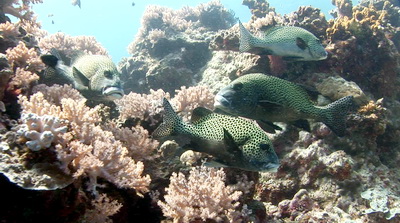 3 pm: Back on the boat we gear up for the next dive. The dive begins somewhat lull and we start to feel a little bit disappointed. Until the current picks up and bigger fish show up on the reef. A group of fair sized blue fin trevally hunt on the wall, one checks out Tony really close. A lovely little turtle is feeding in the reef, and we follow her for several minutes. She is obviously not the slightest disturbed by our presence, she even checks out the lens of Tony’s video camera.
3 pm: Back on the boat we gear up for the next dive. The dive begins somewhat lull and we start to feel a little bit disappointed. Until the current picks up and bigger fish show up on the reef. A group of fair sized blue fin trevally hunt on the wall, one checks out Tony really close. A lovely little turtle is feeding in the reef, and we follow her for several minutes. She is obviously not the slightest disturbed by our presence, she even checks out the lens of Tony’s video camera.
A really huge giant trevally lazily cruises in the current, we start to swim after it but the fish just keeps out of video distance. Panting we have to give the chase up and end our dive.After all a good dive and happily we swim back to the boat.
Day 3
Dive spots of the day:
- Apo 29
- Lucky Reef
- Apo South
- Menor Island
Again, the weather is excellent. Clear blue sky, no wind and waves promise a great dive day. Diving commences at 7:00 am
Apo 29
Tec Dive – 50m
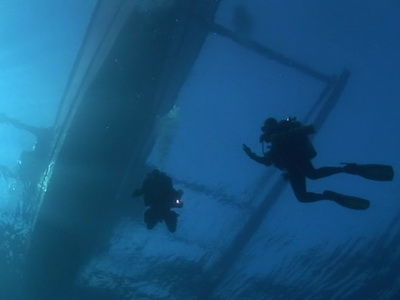 I am going on a tec dive with Ralph today. We plan to descend to the reef plateau at 27m and swim down a slope to 50m to watch the big stuff. On descend we encounter dense fish life, several big schools of midnight snappers, pyramid butterfly fish, rainbow runners, and more.
I am going on a tec dive with Ralph today. We plan to descend to the reef plateau at 27m and swim down a slope to 50m to watch the big stuff. On descend we encounter dense fish life, several big schools of midnight snappers, pyramid butterfly fish, rainbow runners, and more.
We continue the descent, leave the other divers behind and swim down a slope to a drop off at 50m. Not so much fish life there, again the current is not so strong and the really big stuff we hoped to see just doesn’t show up. A couple of whitetip sharks pass by, and then a big fat tuna. A bit disappointed we make a blue water ascent and decompress in open water.
When we are back on board we have to listen what the other divers have seen. They have been much luckier than us techies, they saw many whitetips, huge schools of surgeon fish, fusiliers and red tooth trigger fish, a few intermediate napoleon wrasse, a couple of good sized spanish mackerel and quite a few reasonably sized tuna.
Lucky Reef
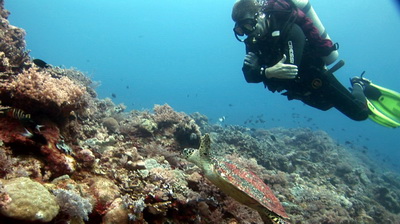 Ralph and I skip this dive since we plan another tec dive at the next dive spot. The other divers are raving when they exit the water. They have seen lots of white tip sharks, schools of blue finned trigger fish, red tooth trigger fish, snappers, groupers and so on. What they liked most on this dive was a big school of barracudas standing effortless in the current.
Ralph and I skip this dive since we plan another tec dive at the next dive spot. The other divers are raving when they exit the water. They have seen lots of white tip sharks, schools of blue finned trigger fish, red tooth trigger fish, snappers, groupers and so on. What they liked most on this dive was a big school of barracudas standing effortless in the current.
Apo South
Tec Dive – 45m
When we descend a whitetip shark already waits for us, circling under the boat. The fish population on this underwater mound is dense, school after school of unicorn fish, rainbow runners, midnight snappers, surgeon fish and some bumphead parrot fish pass by. We swim over to the drop off and encounter a big napoleon wrasse. We are checked out continuously by whitetip sharks. Some bigger tuna and travelley pass by. Fish life, particularly at the drop off at about 20m, is abundant. For whatever reason, there are not much corals here.
Menor Island
I have to skip the dive because of my cold. The others have a magnificent dive, they have seen dozens of sharks, schooling barracudas, some turtles and even a manta ray.
At night, we have a visitor. A big banded seasnake seems to be attracted by the lights and circles the boat several times with its head sticking out of the water.
Day 4
Dive Spots
- Apo Island North Wall
- Apo Island North Wall
- Merope Rock N-E
- Hunter’s Rock
Apo Island North Wall
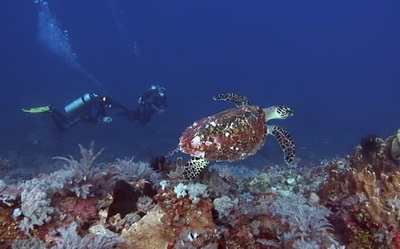 As usual, we begin diving at around 7 am. Again, Ralph and me plan a tec dive to 45 m. This is going to be a deep wall dive. We enter the water and swim over to the drop off. Visibility, as in the previous dives, is excellent, 40 – 50m, and we have a descend current. At the drop off in about 10m we encounter the first white tips, schooling jacks, two massive giant trevallyand some very big tunas. We descend, in about 24m we hit a thermal, the water temperature drops and visibility is suddenly reduced to about 20m. The current picks up and so does fish life. Ralph spots a grey reef sharks. At 45m more and more tunas show up, and these are not the small ones. These are mostly massive dogtooth tuna, there are enormous in size, most far bigger than 1m. Pretty soon we are surrounded by dozens of giant tunas, attracted by Ralph’s strong light, some circling us, some homing in to check us out. You can see clearly their big teeth and huge scars on their bodies from fighting each other. This is really, really impressive, I haven’t seen anything like that in my life. On this dive, going tec truly pays off.
As usual, we begin diving at around 7 am. Again, Ralph and me plan a tec dive to 45 m. This is going to be a deep wall dive. We enter the water and swim over to the drop off. Visibility, as in the previous dives, is excellent, 40 – 50m, and we have a descend current. At the drop off in about 10m we encounter the first white tips, schooling jacks, two massive giant trevallyand some very big tunas. We descend, in about 24m we hit a thermal, the water temperature drops and visibility is suddenly reduced to about 20m. The current picks up and so does fish life. Ralph spots a grey reef sharks. At 45m more and more tunas show up, and these are not the small ones. These are mostly massive dogtooth tuna, there are enormous in size, most far bigger than 1m. Pretty soon we are surrounded by dozens of giant tunas, attracted by Ralph’s strong light, some circling us, some homing in to check us out. You can see clearly their big teeth and huge scars on their bodies from fighting each other. This is really, really impressive, I haven’t seen anything like that in my life. On this dive, going tec truly pays off.
We ascend to shallower depth for our deco obligations. Luckily, the stops are right at the drop off and on the reef plateau so we can observe the vibrant marine life in the shallows: some turtles, a big school of large bumphead parrot fish, schools of big eye trevally, drummers, ribbon sweetlips, black snappers, midnight snappers, surgeon fish and others.
Happily we exit the water. The other divers are pleased, too. Some of them even saw a thresher shark.
Apo Island North Wall II
The last dive was so good that we decide to dive the North Wall again. This time the current is not so strong. Our plan is to descend to 33m on nitrox, but at 25m I can’t equalize and we stay at that depth. This time there is no thermal and you can see all the way down to the bottom of the wall, maybe 60-70m deep. There are some big tunas, but only a few and not as big as the ones we saw on the first dive. Happily we drift in the current along the wall, taking in the colours of and abundant marine life of this great dive site, observing patrolling reef sharks, turtles, several schools of bigeye trevally, a school of good sized barracudas and lots and lots of other reef fish.
While on the way to the next dive spot dolphins show up. They swim just next to the boat, criss-crossing the bow and jumping playfully.
Merope Rock N-E
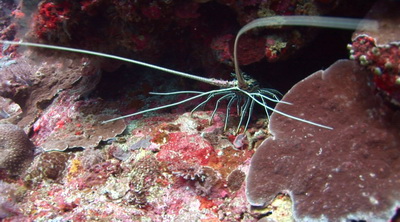 We descend on this underwater mound and regrettably there is not much to see. A giant coral mount is the high light of the dive, but fish life is pretty absent. Some of our divers spot some whitetip sharks in greater depth. Ralph explained beforehand that sometimes, when the current is slack, not so much fish will show up. All in all a rather dull dive and we ascend early.
We descend on this underwater mound and regrettably there is not much to see. A giant coral mount is the high light of the dive, but fish life is pretty absent. Some of our divers spot some whitetip sharks in greater depth. Ralph explained beforehand that sometimes, when the current is slack, not so much fish will show up. All in all a rather dull dive and we ascend early.
On transfer to Hunter’s Rock we spot a geyser of air and water as a whale exhales through his blow hole.
Hunter’s Rock
This is another underwater mound with giant rocks coming close to surface. The underwater scenery is very nice, something completely different from the other dives. Visibility like always is very good, we see a big moray eel, a big potato cod grouper, school of sweetlips, a little hawksbill turtle, thousands of tiny glass fish swimming around a big boulder,a pair of tawny sharks under a rock, some whitetip sharks and eerie rock formations and canyons. Another nice dive.
Day 5
Dive Spots
- Akitsushima Wreck
- Olympia Maru Wreck (Tangat Wreck)
- Ekkai Maru Wreck (formerly Olympia Maru)
- East Tangat Wreck
Akitsushima Wreck
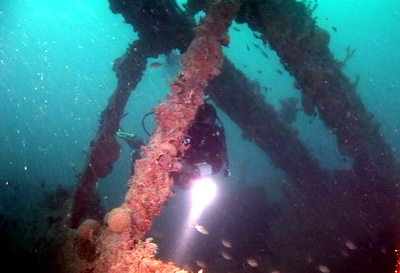 After an eventful night we arrive in the Coron Islands. We gear up for our first dive at the famous Akitsushima Wreck. Ralph and I are going tec on this dive. We enter the wreck at a big crack near the stern of the ship. A few meters inside the dome shaped entry point we stage our oxygen tanks for later retrieval. Ralph ties up a line and squeezes through a crack deeper into the wreck. The visibility, which was terrible outside the wreck, is much better inside. Or so I think, since you can not see very far anyway. We have to be very careful, since the bottom is covered deeply with mud and silt. A wrong movement with the fins, the silt would be stirred up, called a silt-out, visibility would be wiped out and we would have to feel our way out along the line Ralph laid. If we would have silt out and lose the line we very possibly would die. This, in essence, is technical wreck diving. I am a beginner in technical wreck diving and I just make sure to follow Ralph’s instructions to the point.
After an eventful night we arrive in the Coron Islands. We gear up for our first dive at the famous Akitsushima Wreck. Ralph and I are going tec on this dive. We enter the wreck at a big crack near the stern of the ship. A few meters inside the dome shaped entry point we stage our oxygen tanks for later retrieval. Ralph ties up a line and squeezes through a crack deeper into the wreck. The visibility, which was terrible outside the wreck, is much better inside. Or so I think, since you can not see very far anyway. We have to be very careful, since the bottom is covered deeply with mud and silt. A wrong movement with the fins, the silt would be stirred up, called a silt-out, visibility would be wiped out and we would have to feel our way out along the line Ralph laid. If we would have silt out and lose the line we very possibly would die. This, in essence, is technical wreck diving. I am a beginner in technical wreck diving and I just make sure to follow Ralph’s instructions to the point.
The scenery inside the wreck is eerie. We squeeze through narrow gangways inside a big engine room. I can see gigantic diesel engines covered in fine silt, which looks like dust. We squeeze by the engines; I can make out armatures, dials and gauges, mostly overgrown with corals or covered withsilt. Very soon we have reached our return point and slowly dive back to the exit. Outside we have a swim along the hull and the huge crane which was used to lift an airplane on board. As mentioned, the visibility outside is bad, about 8m, but there is a lot of marine life. After an hour we end our dive, retrieve our stage oxygen tanks and start deco procedures. This was my first deeper wreck penetration and a truly thrilling dive.
Olympia Maru Wreck (Tangat Wreck)
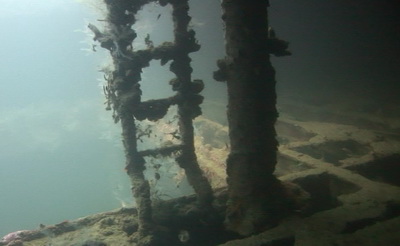 The Olympia Maru is a really huge wreck and we penetrate at the stern. This time we don’t need a line since this is very easy to dive (according to Ralph’s standards). After staging our deco tanks we enter the upper deck at 24m. The ceiling of this deck has collapsed on the inner side, creating along narrow triangle shaped tunnel, the bottom covered in deep silt. Vis is good inside the wreck and at the end of the tunnel huge cargo holds open up. The holds,platforms, decks,ladders, pipes and different machinery we pass by are bathed in a ghostly greenish light. As we make our way from one cargo hold to the other I truly enjoy the supernatural scenery. Everything looks just like in a TV documentary about ship wrecks, like the Titanic or Bismarck. We exit the wreck at the stern and dive around the rudder. Fish life is really amazing, the whole outer wreck is covered in soft and hard corals and there is fish life everywhere. Even some schools of big eye trevally pass by, and the rudder area is home of a group of about 20 big snappers. The fish here come really close since this is a marine sanctuary and they are not scared. There are lot of huge lion fish and scorpion fish. Just too bad that the visibility is so bad on the outside of the wreck. We end our dive, collect our stage tanks and start ascending.
The Olympia Maru is a really huge wreck and we penetrate at the stern. This time we don’t need a line since this is very easy to dive (according to Ralph’s standards). After staging our deco tanks we enter the upper deck at 24m. The ceiling of this deck has collapsed on the inner side, creating along narrow triangle shaped tunnel, the bottom covered in deep silt. Vis is good inside the wreck and at the end of the tunnel huge cargo holds open up. The holds,platforms, decks,ladders, pipes and different machinery we pass by are bathed in a ghostly greenish light. As we make our way from one cargo hold to the other I truly enjoy the supernatural scenery. Everything looks just like in a TV documentary about ship wrecks, like the Titanic or Bismarck. We exit the wreck at the stern and dive around the rudder. Fish life is really amazing, the whole outer wreck is covered in soft and hard corals and there is fish life everywhere. Even some schools of big eye trevally pass by, and the rudder area is home of a group of about 20 big snappers. The fish here come really close since this is a marine sanctuary and they are not scared. There are lot of huge lion fish and scorpion fish. Just too bad that the visibility is so bad on the outside of the wreck. We end our dive, collect our stage tanks and start ascending.
Ekkai Maru Wreck (formerly Olympia Maru)
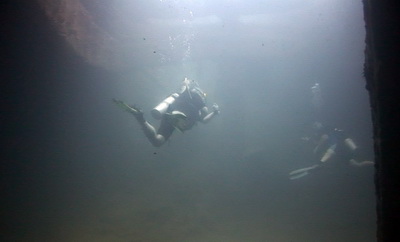 According to Ralph’s plan, we can enter the wreck through a tiny tunnel where the shaft to the propeller used to come out. After we stage our deco tanks he enters this tunnel and promptly gets stuck, he tries hard to get through but after a while he has to give up and wiggles back out. We search for another entry, I look around a bit and when I turn back I just see his fins disappearing inside another tiny hole, like he is swallowed by the ship. This time he makes it through and I follow him. Inside the wreck we squirm and twist our way through tiny gaps and cracks, up and down, while exploring cabins, machine rooms, decks, compartments and cargo holds. This is not as dangerous as it might sound since everywhere are openings and holes to the outside. This is really great fun. Time passes by quickly and soon enough we have to collect our stage tanks and ascend.
According to Ralph’s plan, we can enter the wreck through a tiny tunnel where the shaft to the propeller used to come out. After we stage our deco tanks he enters this tunnel and promptly gets stuck, he tries hard to get through but after a while he has to give up and wiggles back out. We search for another entry, I look around a bit and when I turn back I just see his fins disappearing inside another tiny hole, like he is swallowed by the ship. This time he makes it through and I follow him. Inside the wreck we squirm and twist our way through tiny gaps and cracks, up and down, while exploring cabins, machine rooms, decks, compartments and cargo holds. This is not as dangerous as it might sound since everywhere are openings and holes to the outside. This is really great fun. Time passes by quickly and soon enough we have to collect our stage tanks and ascend.
East Tangat Wreck
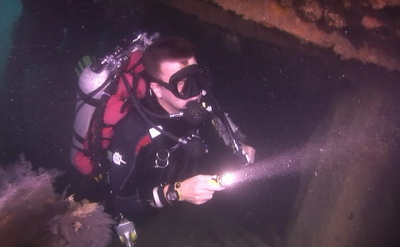 This is little wreck sits in a very nice bay, the scenery is beautiful. Ralph and I have enough diving for the day after three long decompression dives. The other divers conduct a night dive at the wreck. Rob has a malfunctioning regulator and is quickly back on the surface. Tony films some hunting lion fish. He says after the dive that his video lights brought death to lots of cardinal fish; every time he puts the lights on one of them a lion fish swims over and sucks it up.
This is little wreck sits in a very nice bay, the scenery is beautiful. Ralph and I have enough diving for the day after three long decompression dives. The other divers conduct a night dive at the wreck. Rob has a malfunctioning regulator and is quickly back on the surface. Tony films some hunting lion fish. He says after the dive that his video lights brought death to lots of cardinal fish; every time he puts the lights on one of them a lion fish swims over and sucks it up.
Day 6
Dive Spots
- Irako Maru Wreck
- Kogyo Maru
Irako Maru Wreck
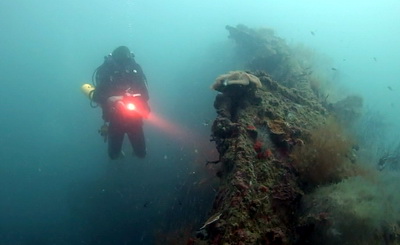 The Irako Maru is a huge wreck; the upper deck in about 32m. Our boat has an engine problem Ralph has to take care of and so Tony and I team up as a buddy team on nitrox for this dive. We descend along the mooring line and we notice some damage on the line. We descend further until we hit the deck at the heavily damaged superstructure. Visibility is very poor and since we are on nitrox we can not go much deeper inside the wreck. We see some snappers, bat fish and lion fish, but actually not so much marine life. The bow of the boat looks exactly like that on the Titanic, so I do a little movie enactment, position myself on the edge and spread my arms like I am flying. Tony is running very low on air (as he does on every dive…!) and we swim back to the ascend line; which is not there, just an enormous cloud of silt. The line has ripped off and we ascend in open water and are picked up by the boat.
The Irako Maru is a huge wreck; the upper deck in about 32m. Our boat has an engine problem Ralph has to take care of and so Tony and I team up as a buddy team on nitrox for this dive. We descend along the mooring line and we notice some damage on the line. We descend further until we hit the deck at the heavily damaged superstructure. Visibility is very poor and since we are on nitrox we can not go much deeper inside the wreck. We see some snappers, bat fish and lion fish, but actually not so much marine life. The bow of the boat looks exactly like that on the Titanic, so I do a little movie enactment, position myself on the edge and spread my arms like I am flying. Tony is running very low on air (as he does on every dive…!) and we swim back to the ascend line; which is not there, just an enormous cloud of silt. The line has ripped off and we ascend in open water and are picked up by the boat.
Kogyo Maru
When Tony and I descend on the Kogyo Maru we can see right away that this will be a great dive. For once, visibility is better, around 10m or so, and the wreck is not so deep. But it’s covered with hard corals such as table and lettuce corals also soft corals and huge bushes of black coral. This looks already like a beautiful coral reef right out of a dive resort’s advertisement. As we descend deeper huge cargo holds open up and create one gigantic cavern after the other. Here the visibility is even better. Some caverns are partially filled with fencing material, bags of concrete and other construction material, others are empty. Some caverns are inhabited by schools of snappers and other schooling fish. We make our way to the bow and back. Right at the bridge is big crack where we dive into. Light is streaming through the crack and other holes, apparently enough to develop a gorgeous coral garden. Back at the ascend line we are surrounded by curious fish life: sweetlips, bigeye trevalley, snappers and others swim up to us and our photographers are delighted. Too soon we have to end our dive and ascend to surface.
After another dive at the Kogyo Maru we start our journey back to Puerto Galera.
The ride again is smooth and we arrive in Puerto Galera late morning. After all, this has been a truly amazing trip. We had exceptionally good weather and we greatly enjoyed the diving and time we spent on board of Rags II. Ralph has done an outstanding job, not only as a boat manager but also as a diver. One can clearly see that he hasn’t lost his passion for diving as he tries do join every dive he can, especially tec dives. I already make plans to come back to Puerto Galera for technical wreck and cave diving courses




